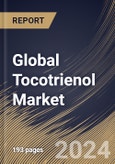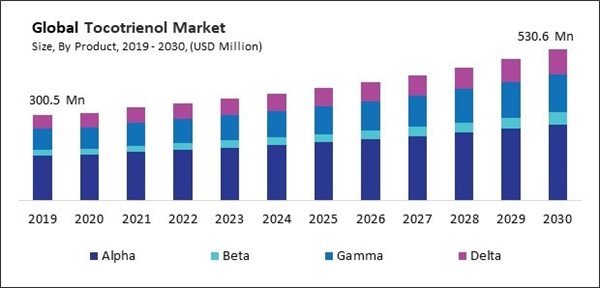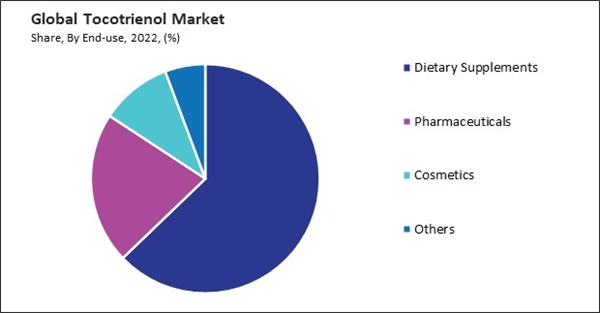The Global Tocotrienol Market size is expected to reach $530.6 million by 2030, rising at a market growth of 5.8% CAGR during the forecast period.
Tocotrienols are often included in dietary supplements to promote overall health and well-being. Consequently, the dietary supplements segment generate a 60.88% Share in the market by 2030. As demand for these supplements rises, so does the demand for tocotrienols as a key ingredient. Therefore, the rising demand for natural and functional ingredients is propelling the growth of the market.
Advanced extraction technologies enable manufacturers to extract tocotrienols from natural sources more efficiently. These technologies may involve innovative methods such as supercritical fluid extraction, molecular distillation, or chromatography, resulting in higher yields and lower production costs. In conclusion, ongoing advancements in extraction and formulation technologies drive the market’s growth.
Additionally, As people age, they become more susceptible to various health issues such as cardiovascular diseases, cognitive decline, and age-related macular degeneration. As potent antioxidants, tocotrienols have been studied for their potential role in supporting cardiovascular health. The aging population’s heightened awareness of these health concerns drives the demand for tocotrienol-rich supplements. Thus, the expansion of the global aging population is driving the market’s growth.
However, Tocotrienols are a form of vitamin E found in certain natural sources like palm oil and rice bran. Extracting tocotrienols from these sources involves a complex process that requires specific equipment and expertise. The cost of acquiring and maintaining this equipment contributes to the high cost of production. Furthermore, the yield of tocotrienols from natural sources may be relatively low compared to other products. In conclusion, the high production cost is hampering the market’s growth.
However, Restrictions on movement, border closures, and lockdown measures in various countries disrupted transportation and logistics networks, leading to delays in procuring raw materials and production inputs for tocotrienol manufacturers. Thus, the COVID-19 pandemic had a negative impact on the market.
Tocotrienols are often included in dietary supplements to promote overall health and well-being. Consequently, the dietary supplements segment generate a 60.88% Share in the market by 2030. As demand for these supplements rises, so does the demand for tocotrienols as a key ingredient. Therefore, the rising demand for natural and functional ingredients is propelling the growth of the market.
Advanced extraction technologies enable manufacturers to extract tocotrienols from natural sources more efficiently. These technologies may involve innovative methods such as supercritical fluid extraction, molecular distillation, or chromatography, resulting in higher yields and lower production costs. In conclusion, ongoing advancements in extraction and formulation technologies drive the market’s growth.
Additionally, As people age, they become more susceptible to various health issues such as cardiovascular diseases, cognitive decline, and age-related macular degeneration. As potent antioxidants, tocotrienols have been studied for their potential role in supporting cardiovascular health. The aging population’s heightened awareness of these health concerns drives the demand for tocotrienol-rich supplements. Thus, the expansion of the global aging population is driving the market’s growth.
However, Tocotrienols are a form of vitamin E found in certain natural sources like palm oil and rice bran. Extracting tocotrienols from these sources involves a complex process that requires specific equipment and expertise. The cost of acquiring and maintaining this equipment contributes to the high cost of production. Furthermore, the yield of tocotrienols from natural sources may be relatively low compared to other products. In conclusion, the high production cost is hampering the market’s growth.
However, Restrictions on movement, border closures, and lockdown measures in various countries disrupted transportation and logistics networks, leading to delays in procuring raw materials and production inputs for tocotrienol manufacturers. Thus, the COVID-19 pandemic had a negative impact on the market.
By End-Use Analysis
On the basis of end-use, the market is segmented into dietary supplements, pharmaceuticals, cosmetics, and others. The dietary supplements segment acquired 62.8% revenue share in the market in 2022. Rich in antioxidants, tocotrienols aid in the body’s reduction of oxidative stress by scavenging dangerous free radicals. Given the prevalence of oxidative damage contributing to various chronic diseases and aging processes, consumers increasingly turn to dietary supplements containing tocotrienols to enhance their antioxidant defenses and protect against cellular damage.By Product Analysis
Based on product, the market is divided into alpha, beta, gamma, and delta. The gamma segment acquired 24.5% revenue share in the market in 2022. Gamma-tocotrienol has shown promising neuroprotective effects in preclinical studies. It has been demonstrated to efficiently pass the blood-brain barrier and shield brain tissue from oxidative stress, potentially delaying or preventing the onset of neurodegenerative illnesses like Parkinson’s and Alzheimer’s.By Regional Analysis
Region-wise, the market is analyzed across North America, Europe, Asia Pacific, and LAMEA. The Asia Pacific region generated a 19.65% revenue share in the market in 2022. Manufacturers and retailers in the Asia Pacific region increasingly incorporate tocotrienols into a wide range of products, including dietary supplements, functional foods, cosmetics, and personal care products. Product innovation, coupled with effective marketing strategies highlighting the health and beauty benefits of tocotrienols, drives consumer awareness and demand for these products in the region.List of Key Companies Profiled
- Parchem Fine and Specialty Chemicals, Inc.
- BASF SE
- Eisai Co., Ltd.
- Cayman Chemical Company, Inc.
- Excelvite SDN. BHD.
- BTSA BIOTECNOLOGÍAS APLICADAS S.L.
- American River Nutrition, LLC
- Vance Group Ltd.
- Kuala Lumpur Kepong Berhad (Davos Life Science)
- SourceOne Global Partners
Market Report Segmentation
By Product- Alpha
- Beta
- Gamma
- Delta
- Dietary Supplements
- Pharmaceuticals
- Cosmetics
- Others
- North America
- US
- Canada
- Mexico
- Rest of North America
- Europe
- Germany
- UK
- France
- Russia
- Spain
- Italy
- Rest of Europe
- Asia Pacific
- China
- Japan
- India
- South Korea
- Singapore
- Malaysia
- Rest of Asia Pacific
- LAMEA
- Brazil
- Argentina
- UAE
- Saudi Arabia
- South Africa
- Nigeria
- Rest of LAMEA
Table of Contents
Chapter 1. Market Scope & Methodology
Chapter 2. Market at a Glance
Chapter 3. Market Overview
Chapter 4. Global Tocotrienol Market, by Product
Chapter 5. Global Tocotrienol Market, by End-use
Chapter 6. Global Tocotrienol Market, by Region
Chapter 7. Company Profiles
Companies Mentioned
- Parchem Fine and Specialty Chemicals, Inc.
- BASF SE
- Eisai Co., Ltd.
- Cayman Chemical Company, Inc.
- Excelvite SDN. BHD.
- BTSA BIOTECNOLOGÍAS APLICADAS S.L.
- American River Nutrition, LLC
- Vance Group Ltd.
- Kuala Lumpur Kepong Berhad (Davos Life Science)
- SourceOne Global Partners
Methodology

LOADING...










